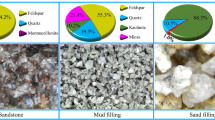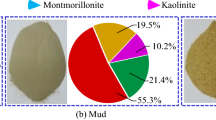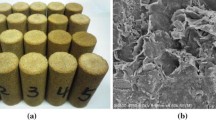Abstract
Rock masses are typical inhomogeneous geological materials that contain many fissures and cracks. The coupling effect of the crack propagation and seepage evolution in rocks is very important to the safety of rock engineering. However, hydromechanical coupling behavior during the failure of fissured rocks has rarely been investigated. In this research, hydromechanical coupling tests are performed to fully explore the behaviors in strength, deformation, permeability and failure mode of sandstone samples with two preexisting fissures. The experimental results show that the ratio of crack initiation threshold/peak strength, the ratio of crack damage threshold/peak strength and the value of the elastic modulus decrease by at most 31.8%, 12.2% and 18.4% due to the existence of the two fissures, while the Poisson’s ratio increases by at most 45.6%. Furthermore, the values of permeability before the sudden increase stage range from 2.1% to 17.6% of the maximum permeability value. The influence of bridge length and angle on permeability is more significant under lower confining pressure or higher water pressure. Five failure modes are observed in the double-fissure samples under hydromechanical coupling conditions. Additionally, the “wing cracks + indirect coalescence” failure mode is generated only when the ligament length is shorter than the fissure length. The corresponding strength is lower than that for other failure modes. CT images show that the expansion of cracks inside the samples is more restricted than that at the surface of the samples, especially near the rock bridge region. The effects of failure modes on the mechanical and permeability properties, from greatest to least, are as follows: crack initiation threshold, peak strength, crack damage threshold, elastic modulus, Poisson’s ratio and permeability. This research is contributed to analyze the stability of water-bearing rocks in underground caverns with many preexisting fissures.






(modified from Martin and Chandler 1994)















Similar content being viewed by others
Abbreviations
- W:
-
Wing crack
- AW:
-
Anti-wing crack
- INC:
-
Indirect coalescence
- SC:
-
Secondary crack
- NC:
-
No coalescence
- DC:
-
Direct coalescence
- UCS:
-
Uniaxial compression strength
- ρ :
-
Density
- n :
-
Initial porosity
- σ t :
-
Tensile strength
- E :
-
Elastic modulus
- μ :
-
Poisson’s ratio
- C :
-
Cohesion
- φ :
-
Friction angle
- K :
-
Softening factor
- k :
-
Permeability
- Q :
-
Water flow rate
- A :
-
Cross-sectional area of the sample
- μ f :
-
Dynamic viscosity of the fluid
- ΔP :
-
Water pressure difference applied between both end planes of the rock sample
- H :
-
Height of sample
- D :
-
Diameter of sample
- a :
-
Half-length of the fissure
- b :
-
Width of the fissure
- α :
-
Fissure dip angle
- L :
-
Rock bridge ligament length
- β :
-
Rock bridge angle
- P c :
-
Confining pressure
- P w :
-
Water pressure
- ε 1 :
-
Axial strain
- ε 3 :
-
Lateral strain
- ε v :
-
Volumetric strain
- ε vc :
-
Crack-induced volumetric strain
- σ 1 :
-
Axial stress
- σ 3 :
-
Confining pressure
- σ cc :
-
Primary crack closure threshold
- σ ci :
-
Crack initiation threshold
- σ cd :
-
Crack damage threshold
- σ c :
-
Peak strength
- σ r :
-
Residual strength
- k 0 :
-
Initial permeability
- k ci :
-
Permeability corresponding to the crack initiation threshold
- k cd :
-
Permeability corresponding to the crack damage threshold
- k c :
-
Permeability corresponding to the peak strength
- k max :
-
Maximum permeability
References
Afolagboye LO, He JM, Wang SJ (2018) Crack initiation and coalescence behavior of two non-parallel flaws. Geotech Geol Eng 36(1):105–133
Bahaaddini M, Sharrock G, Hebblewhite BK (2013) Numerical investigation of the effect of joint geometrical parameters on the mechanical properties of a non-persistent jointed rock mass under uniaxial compression. Comput Geotech 49:206–225
Bieniawski ZT (1967) Mechanism of brittle fracture of rock: part I—theory of the fracture process. Int J Rock Mech Min Sci Geomech Abstr 4(4):395–406
Brace WF, Walsh JB, Frangos WT (1968) Permeability of granite under high pressure. J Geophys Res 73(6):2225–2236
Cai M, Kaiser PK, Tasaka Y, Maejima T, Morioka H, Mianami M (2004) Generalized crack initiation and crack damage stress thresholds of brittle rock masses near underground excavations. Int J Rock Mech Min Sci 41(5):833–847
Cai YY, Chen X, Yu J, Zhou JF (2018) Numerical study on the evolution of mesoscopic properties and permeability in sandstone under hydromechanical coupling conditions involving industrial internet of things. IEEE Access 6:11804–11815
Cao P, Liu TY, Pu CZ, Lin H (2015) Crack propagation and coalescence of brittle rock-like specimens with pre-existing cracks in compression. Eng Geol 187:113–121
Chen YL (2016) Experimental study of the stress dependence of the permeability of rock. Geotech Geol Eng 34(5):1571–1575
Chen X, Yu J, Tang CA, Li H, Wang SY (2017) Experimental and numerical investigation of permeability evolution with damage of sandstone under triaxial compression. Rock Mech Rock Eng 50(6):1529–1549
Chen X, Tang CA, Yu J, Zhou JF, Cai YY (2018) Experimental investigation on deformation characteristics and permeability evolution of rock under confining pressure unloading conditions. J Cent South Univ 25(8):1987–2001
Davy CA, Skoczylas F, Barnichon JD et al (2007) Permeability of macro-cracked argillite under confinement: gas and water testing. Phys Chem Earth 32(8–14):667–680
Eberhardt E, Stimpson B, Read RS, Stead D (1998) Identifying crack initiation and propagation thresholds in brittle rock. Can Geotech J 35(2):222–233
Fu JW, Chen K, Zhu WS, Zhang XH, Li XJ (2016) Progressive failure of new modelling material with a single internal crack under biaxial compression and the 3-D numerical simulation. Eng Fract Mech 165:140–152
Fu JW, Zhang XH, Zhu WS, Chen K, Guan JF (2017) Simulating progressive failure in brittle jointed rock masses using a modified elastic-brittle model and the application. Eng Fract Mech 178:212–230
Haeri H, Shahriar K, Marji MF, Moarefvand P (2014) Cracks coalescence mechanism and cracks propagation paths in rock-like specimens containing pre-existing random cracks under compression. J Cent South Univ 21(6):2404–2414
Huang D, Gu DM, Yang C, Huang RQ, Fu GY (2016a) Investigation on mechanical behaviors of sandstone with two preexisting flaws under triaxial compression. Rock Mech Rock Eng 49:375–399
Huang YH, Yang SQ, Zhao J (2016b) Three-dimensional numerical simulation on triaxial failure mechanical behavior of rock-like specimen containing two unparallel fissures. Rock Mech Rock Eng 49(12):4711–4729
Huang YH, Yang SQ, Tian WL (2019) Crack coalescence behavior of sandstone specimen containing two pre-existing flaws under different confining pressures. Theor Appl Fract Mech 99:118–130
Janeiro RP, Einstein HH (2010) Experimental study of the cracking behavior of specimens containing inclusions (under uniaxial compression). Int J Fract 164(1):83–102
Lee H, Jeon S (2011) An experimental and numerical study of fracture coalescence in pre-cracked specimens under uniaxial compression. Int J Solids Struct 48(6):979–999
Lee J, Ha YD, Hong JW (2017) Crack coalescence morphology in rock-like material under compression. Int J Fract 203(1–2):211–236
Li TC, Lyu LX, Zhang SL, Sun JC (2015) Development and application of a statistical constitutive model of damaged rock affected by the load-bearing capacity of damaged elements. J Zhejiang Univ Sci A 16(8):644–655
Li WT, Yang N, Mei YC, Zhang YH, Wang L, Ma HY (2020) Experimental investigation of the compression-bending property of the casing joints in a concrete filled steel tubular supporting arch for tunnel engineering. Tunn Undergr Space Technol 96:103184. https://doi.org/10.1016/j.tust.2019.103184
Lu ZD, Chen CX, Feng XT, Zhang YL (2014) Strength failure and crack coalescence behavior of sandstone containing single pre-cut fissure under coupled stress, fluid flow and changing chemical environment. J Cent South Univ 21(3):1176–1183
Lu YL, Wang LG, Elsworth D (2015) Uniaxial strength and failure in sandstone containing a pre-existing 3-D surface flaw. Int J Fract 194(1):59–79
Martin CD, Chandler NA (1994) The progressive fracture of lac du bonnet granite. Int J Rock Mech Min Sci Geomech Abstr 31(6):643–659
Morgan SP, Johnson C, Einstein HH (2013) Cracking processes in Barre granite: fracture process zones and crack coalescence. Int J Fract 180(2):177–204
Oda M, Takemura T, Aoki T (2002) Damage growth and permeability change in triaxial compression tests of Inada granite. Mech Mater 34(6):313–331
Park CH, Bobet A (2009) Crack coalescence in specimens with open and closed flaws: a comparison. Int J Rock Mech Min Sci 46(5):819–829
Park CH, Bobet A (2010) Crack initiation, propagation and coalescence from frictional flaws in uniaxial compression. Eng Fract Mech 77(14):2727–2748
Prudencio M, Van SJM (2007) Strength and failure modes of rock mass models with non-persistent joints. Int J Rock Mech Min Sci 44(6):890–902
Sun Q, Xue L, Zhu SY (2015) Permeability evolution and rock brittle failure. Acta Geophys 63(4):978–999
Tang Y, Okubo S, Xu J, Peng SJ (2019) Progressive failure behaviors and crack evolution of rocks under triaxial compression by 3D digital image correlation. Eng Geol 249:172–185
Wang HL, Xu WY, Shao JF (2014a) Experimental researches on hydro-mechanical properties of altered rock under confining pressures. Rock Mech Rock Eng 47(2):485–493
Wang SY, Sloan SW, Sheng DC, Yang SQ, Tang CA (2014b) Numerical study of failure behaviour of pre-cracked rock specimens under conventional triaxial compression. Int J Solids Struct 51(5):1132–1148
Wang L, Liu JF, Pei JL, Xu HN, Bian Y (2015) Mechanical and permeability characteristics of rock under hydro-mechanical coupling conditions. Environ Earth Sci 73(10):5987–5996
Wang HL, Xu WY, Lu ZB, Chao ZM, Meng QX (2016a) Dependency of hydromechanical properties of monzonitic granite on confining pressure and fluid pressure under compression. Int J Mod Phys B. https://doi.org/10.1142/S0217979216500867
Wang HL, Xu WY, Jia CJ, Cai M, Meng QX (2016b) Experimental research on permeability evolution with microcrack development in sandstone under different fluid pressures. J Geotech Geoenviron. https://doi.org/10.1061/(asce)gt.1943-5606.0001462
Wang YL, Tang JX, Dai ZY, Yi T (2018) Experimental study on mechanical properties and failure modes of low-strength rock samples containing different fissures under uniaxial compression. Eng Fract Mech 197:1–20
Wang G, Han W, Jiang YJ, Luan HJ, Wang K (2019) Coupling analysis for rock mass supported with CMC or CFC rockbolts based on viscoelastic method. Rock Mech Rock Eng 52(11):4565–4588
Wong LNY, Einstein HH (2009) Systematic evaluation of cracking behavior in specimens containing single flaws under uniaxial compression. Int J Rock Mech Min Sci 46(2):239–249
Wong LNY, Li HQ (2013) Numerical study on coalescence of two pre-existing coplanar flaws in rock. Int J Solids Struct 50(22–23):3685–3706
Wu JY, Feng MM, Han GS, Yao BY, Ni XY (2019) Loading rate and confining pressure effect on dilatancy, acoustic emission, and failure characteristics of fissured rock with two pre-existing flaws. C R Mecanique 347(1):62–89
Wyckoff RD, Botset HG, Muskat M, Reed DW (1933) The measurement of the permeability of porous media for homogeneous fluid. Rev Sci Instrum 4(7):394–405
Yang SQ, Huang YH (2017) An experimental study on deformation and failure mechanical behavior of granite containing a single fissure under different confining pressures. Environ Earth Sci 76(10):1–22
Yang SQ, Jing HW (2011) Strength failure and crack coalescence behavior of brittle sandstone samples containing a single fissure under uniaxial compression. Int J Fract 168(2):227–250
Yang SQ, Jiang YZ, Xu WY, Chen XQ (2008) Experimental investigation on strength and failure behavior of pre-cracked marble under conventional triaxial compression. Int J Solids Struct 45(17):4796–4819
Yang SQ, Huang YH, Tian WL, Zhu JB (2017) An experimental investigation on strength, deformation and crack evolution behavior of sandstone containing two oval flaws under uniaxial compression. Eng Geol 217:38–48
Yang SQ, Huang YH, Ranjith PG (2018) Failure mechanical and acoustic behavior of brine saturated-sandstone containing two pre-existing flaws under different confining pressures. Eng Fract Mech 193:108–121
Yin P, Wong RHC, Chau KT (2014) Coalescence of two parallel pre-existing surface cracks in granite. Int J Rock Mech Min Sci 68:66–84
Yu J, Chen SJ, Chen X, Zhang YZ, Cai YY (2015) Experimental investigation on mechanical properties and permeability evolution of red sandstone after heat treatments. J Zhejiang Univ Sci A 16(9):749–759
Zeng W, Yang SQ, Tian WL, Wen K (2018) Numerical investigation on permeability evolution behavior of rock by an improved flow-coupling algorithm in particle flow code. J Cent South Univ 25(6):1367–1385
Zhang R, Jiang ZQ, Sun Q, Zhu SY (2013) The relationship between the deformation mechanism and permeability on brittle rock. Nat Hazards 66(2):1179–1187
Zhao YL, Zhang LY, Wang WJ, Pu CZ, Wan W, Tang JZ (2016) Cracking and stress–strain behavior of rock-like material containing two flaws under uniaxial compression. Rock Mech Rock Eng 49(7):2665–2687
Zhao YL, Tang JZ, Chen Y, Zhang LY, Wang WJ, Wan W, Liao JP (2017) Hydromechanical coupling tests for mechanical and permeability characteristics of fractured limestone in complete stress–strain process. Environ Earth Sci 76(1):24
Zhao C, Niu JL, Zhang QZ, Zhao CF, Zhou YM (2019) Failure characteristics of rock-like materials with single flaws under uniaxial compression. Bull Eng Geol Environ 78(1):593–603
Zhou XP, Cheng H, Feng YF (2014) An experimental study of crack coalescence behaviour in rock-like materials containing multiple flaws under uniaxial compression. Rock Mech Rock Eng 47(6):1961–1986
Zhou T, Zhu JB, Ju Y, Xie HP (2019) Volumetric fracturing behavior of 3D printed artificial rocks containing single and double 3D internal flaws under static uniaxial compression. Eng Fract Mech 205:190–204
Acknowledgements
This study was supported by the National Natural Science Foundation of China (Nos. 41772299, 51279096) and the Open Fund Research Project of State Key Laboratory Breeding Base for Mining Disaster Prevention and Control, China (No. MDPC201815).
Author information
Authors and Affiliations
Corresponding author
Ethics declarations
Conflict of interest
The authors declare no conflicts of interest.
Additional information
Publisher's Note
Springer Nature remains neutral with regard to jurisdictional claims in published maps and institutional affiliations.
Rights and permissions
About this article
Cite this article
Du, Y., Li, T., Li, W. et al. Experimental Study of Mechanical and Permeability Behaviors During the Failure of Sandstone Containing Two Preexisting Fissures Under Triaxial Compression. Rock Mech Rock Eng 53, 3673–3697 (2020). https://doi.org/10.1007/s00603-020-02119-x
Received:
Accepted:
Published:
Issue Date:
DOI: https://doi.org/10.1007/s00603-020-02119-x




